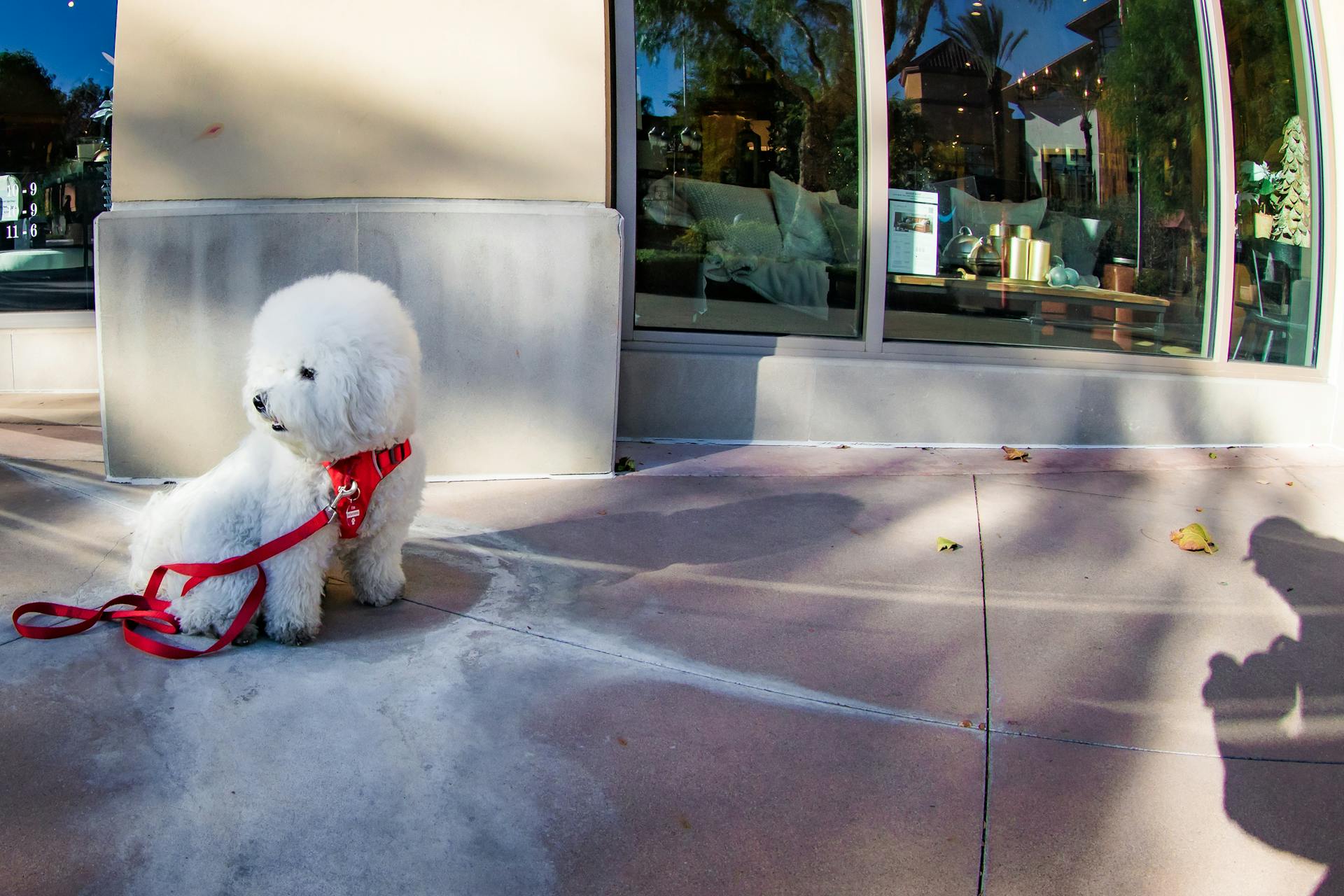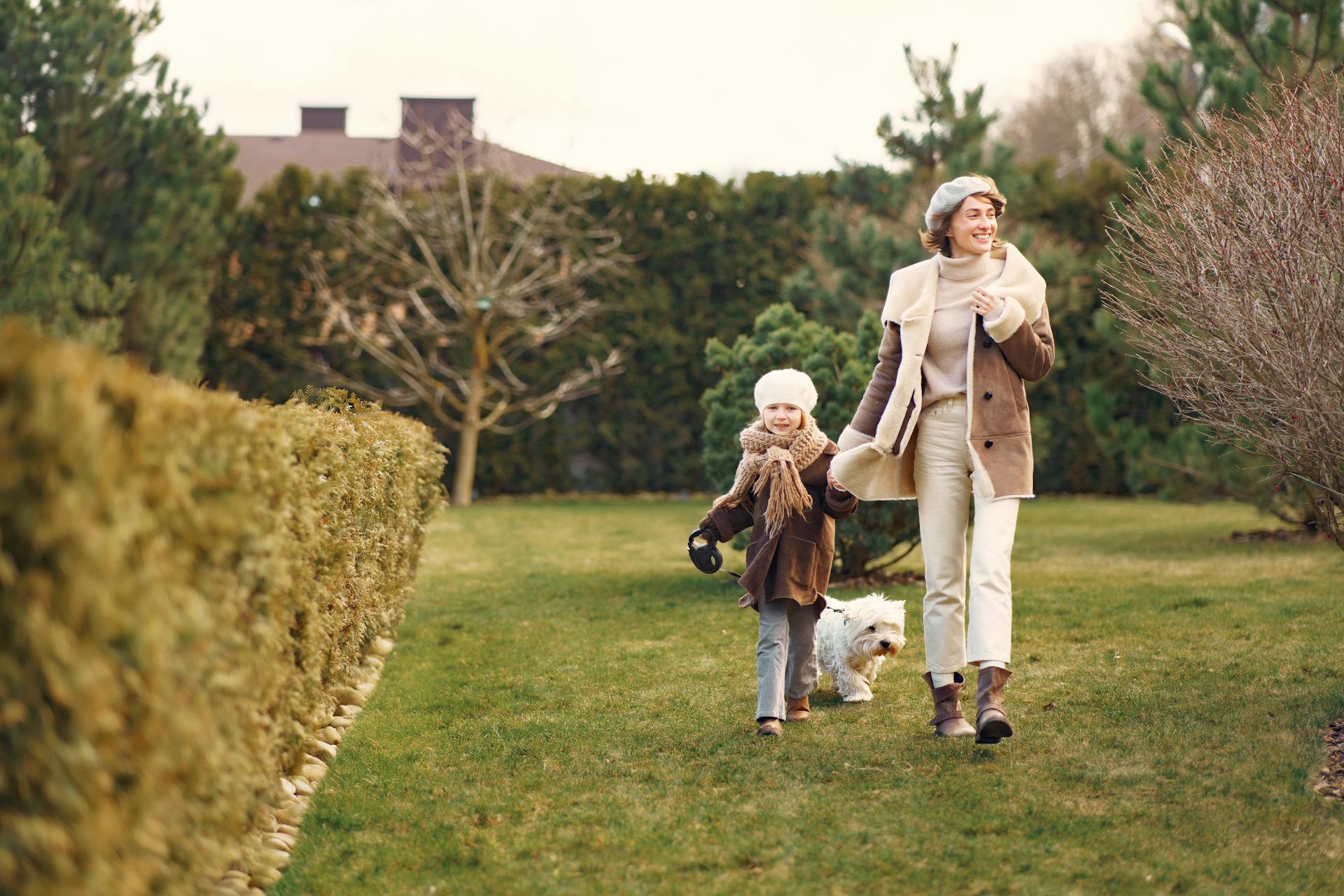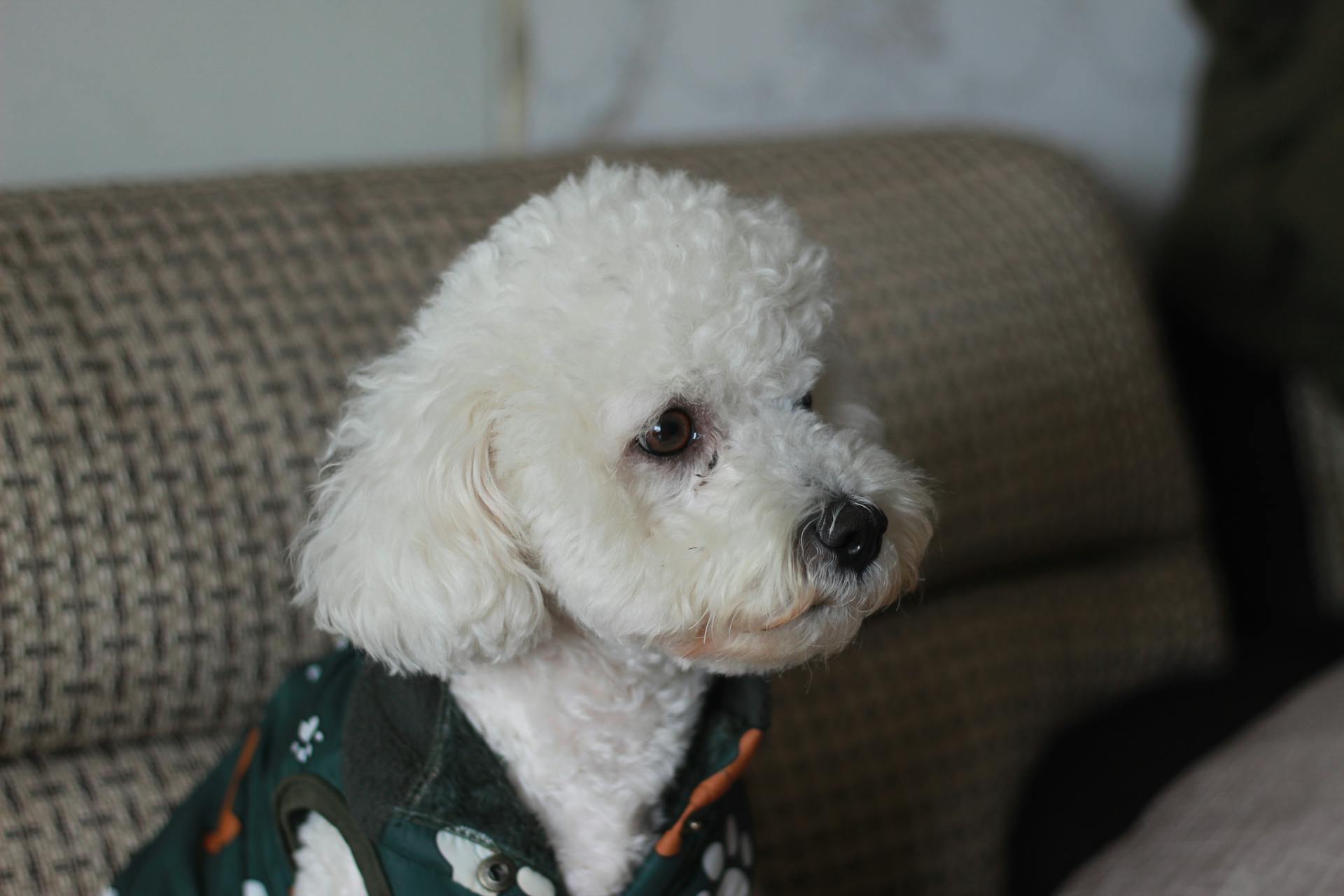
Bichon Frise hot spots are a common issue for these adorable dogs. They can be painful and lead to skin infections if left untreated.
Bichon Frises have a unique coat that requires regular grooming, but it also makes them prone to skin problems. Their thick, curly fur can trap moisture and bacteria, leading to hot spots.
Hot spots can appear anywhere on a Bichon Frise's body, but they often occur on areas with thick fur, such as the legs, chest, and belly. They can be caused by allergies, skin irritations, or even insect bites.
Preventing hot spots requires regular grooming and monitoring of your Bichon Frise's skin. Regular brushing and nail trimming can help reduce the risk of skin problems.
On a similar theme: Bichon Frise Behaviour Problems
What Are Bichon Frise Hot Spots?
Bichon Frise hot spots are a common issue for these adorable dogs. They can be caused by skin allergies, irritation, or even just excessive licking.
Bichon Frises are prone to skin allergies due to their sensitive skin. This can be triggered by environmental factors, food, or even stress.
See what others are reading: Bichon Frise Skin Problems
Regular grooming is essential to prevent and identify hot spots. Brushing your Bichon Frise daily can help distribute skin oils and reduce shedding.
Hot spots can appear anywhere on a Bichon Frise's body, but they often occur on the belly, chest, and behind the ears. These areas are prone to moisture, which can exacerbate skin issues.
Redness, swelling, and a foul odor are common signs of a hot spot. If you notice any of these symptoms, it's essential to take action quickly to prevent the hot spot from worsening.
Causes and Symptoms
Hot spots on Bichon Frises can be caused by a variety of underlying issues, including allergies, flea bites, ear infections, and skin infections.
These underlying conditions can cause intense itching, leading your dog to scratch and lick the affected area, creating a hot spot. Redness, swelling, hair loss, and skin lesions are common signs of hot spots.
Some common causes of hot spots on Bichon Frises include:
- Allergies- both environmental and food allergies can cause itching
- Insect bites- bites from fleas, mites, and other insects
- Ear Infections- an infection in the ear canal can cause itching so bad the dog creates a hot spot on or around the ear
- Pyoderma- Skin infections caused by bacteria or yeast can incite itching
- Boredom- a bored dog develops bad habits. Dogs lick areas like their feet and forelegs until they are raw.
It's essential to identify the underlying cause of the hot spot to provide effective treatment and prevent future occurrences.
What Does a Dog Spot Look Like?
A hot spot on a dog can be a pretty alarming sight, but it's essential to know what to look for. Hot spots on dogs often look like a large wet scab that oozes.
They can be found on various parts of the dog's body, including the hips, limbs, and head, but can occur anywhere. Hot spots are typically moist and may discharge pus or fluids that can dry to create crusting and matting of hair.
Raw and inflamed skin is another common description of a hot spot. In some cases, the area may even bleed. These affected areas will be red, inflamed, and painful, leading your dog to itch and lick the area.
You might like: Hot Spots on Shih Tzus
What Causes Hot Spots?
Hot spots on dogs can be caused by a variety of factors, and understanding the underlying cause is key to preventing them from recurring.
One of the most common causes of hot spots is excessive scratching, chewing, and licking of an affected area, which can lead to inflammation and secondary infections.
Anal sac disease, atopic dermatitis, and skin infections are just a few examples of conditions that can result in hot spots.
Dogs with dirty or matted coats, or those with contact irritants, can also be prone to hot spots.
Other potential causes include ear infections, flea allergy dermatitis, food allergies, and parasites.
Here are some common conditions that can lead to hot spots:
- Anal sac disease
- Atopic dermatitis
- Coat that is dirty or matted
- Contact irritants
- Ear infections
- Flea allergy dermatitis
- Food allergies
- Moisture trapped in the coat from swimming or bathing
- Parasites
- Skin infections
- Anxiety, stress or boredom resulting in excessive licking
Insect bites, allergies, ear infections, and pyoderma are just a few examples of underlying causes that can lead to hot spots.
Dogs with orthopedic problems, such as arthritis, may also be more prone to hot spots due to increased lying down and pressure on certain areas.
Canine Skin Issues: Signs and Symptoms
Canine skin issues can be a real pain for both dogs and their owners. Redness, swelling, hair loss, and skin lesions are all common signs of hot spots on dogs.
Hot spots are typically found on the hips, limbs, and head, but they can occur anywhere on a dog's body. They're often moist and may discharge pus or fluids that can dry to create crusting and matting of hair.
Take a look at this: Bichon Frise Curly Hair
These affected areas will be red, inflamed, and painful, leading your dog to itch and lick the area. It's essential to contact your veterinarian right away, as hot spots can quickly spread to other parts of the dog's body due to bacterial buildup.
Here are some common conditions that can lead to hot spots:
- Anal sac disease
- Atopic dermatitis
- Coat that is dirty or matted
- Contact irritants
- Ear infections
- Flea allergy dermatitis
- Food allergies
- Moisture trapped in the coat from swimming or bathing
- Parasites
- Skin infections
- Anxiety, stress or boredom resulting in excessive licking
Keep in mind that many of these conditions are chronic problems that require proper management to prevent recurring hot spots.
Are Hot Spots Contagious?
Hot spots can be a real nuisance, and you might be wondering if they're contagious. The good news is that hot spots are not contagious, they're actually a symptom of a bacterial or fungal infection.
Hot spots are usually caused by allergies, skin irritations, or bacterial infections, which can be triggered by a variety of factors such as flea bites, skin allergies, or even certain types of food.
The most common cause of hot spots is a bacterial infection called pyoderma, which can be caused by a variety of bacteria including Staphylococcus and Streptococcus.
Hot spots can be painful and itchy, and they often appear as red, inflamed areas on the skin.
Prevention and Treatment
Preventing hot spots on your Bichon Frise requires regular grooming and hygiene. Careful attention to bathing, flea control, and ear cleaning can help avoid hot spots from developing.
To prevent hot spots, maintain good hygiene and routine grooming, treat skin infections, prevent parasites, and manage allergies. Regular bathing and drying of your dog's coat after swimming or baths can also help prevent hot spots.
You can also use supplementary fatty acids with anti-inflammatory properties to build a healthy skin barrier. Fish oil is a great source of fatty acids and can be used as a dietary supplement.
Here are some ways to prevent hot spots on your Bichon Frise:
If your Bichon Frise does develop a hot spot, treatment involves removing the grouping of bacteria from the skin surface. This can be done by clipping and thoroughly cleaning the affected area. Your veterinarian may prescribe oral or topical medications to treat itch and inflammation, and may also recommend an Elizabethan collar to prevent licking or scratching.
Prevention Methods

Maintaining good hygiene and routine grooming is key to preventing hot spots on your dog. Regular bathing, flea control, and ear cleaning can help avoid hot spots from developing.
Careful attention to your dog's grooming and hygiene can make a big difference in preventing hot spots. In fact, a veterinarian can guide you on the best plan if your pet's hot spots are triggered by an underlying issue like allergic skin disease.
Regular bathing and drying of your dog's coat is crucial if they swim or get baths often. Matted fur that's left wet can create ideal conditions for hot spots to develop.
Supplementary fatty acids with anti-inflammatory properties can also help prevent hot spots. Fish oil is a great source of these fatty acids, packed with Omega-3 fatty acids like DHA and EPA.
Dog Spot Treatment
If your dog has a hot spot, it's essential to treat it carefully to prevent further irritation and infection. You can start by carefully trimming the fur around the lesion to prevent fur from trapping moisture against your dog's skin.
To clean the affected area, use warm water and gently pat dry with a clean cloth or paper towel. Be sure to apply a small amount of an over-the-counter hydrocortisone ointment to stop itching and aid healing.
Preventing your dog from biting, licking, or scratching the hot spot is crucial. You can use a plastic cone or Elizabethan collar to keep your dog from accessing the area. In some cases, your vet may prescribe a short course of an allergy medication or an anti-inflammatory to make your dog more comfortable.
The cost of treating hot spots can be relatively inexpensive if you treat them with urgency. The main costs incurred are typically from the veterinarian's consultation and possible drug costs.
To prevent hot spots, maintain good hygiene and routine grooming, treat skin infections, prevent parasites, and manage allergies. If your dog swims or gets baths often, make sure their coats are completely dried afterward to prevent matted fur from trapping moisture.
Here are some common signs of hot spots on dogs:
- Redness
- Swelling
- Hair loss
- Skin lesions
- Moist, oozing lesions that can discharge pus or fluids
- Crusting and matting of hair
If you suspect your dog has a hot spot, it's essential to contact your veterinarian right away to prevent further irritation and infection.
Sources
- https://www.medvet.com/hot-spots-in-dogs/
- https://www.smalldoorvet.com/learning-center/what-to-do/hot-spot-in-dogs/
- https://spotpet.com/breeds/dog-breeds/bichon-frise
- https://tinylittlepawsvet.medium.com/understanding-bichon-frise-allergies-and-sensitivities-tips-for-allergy-prone-owners-faf31e977ba4
- https://getjoyfood.com/blogs/the-daily-scoop/everything-you-need-to-know-about-hot-spots-on-dogs
Featured Images: pexels.com


